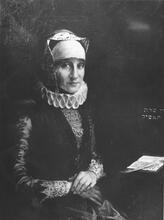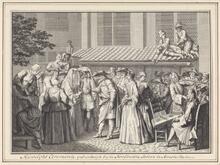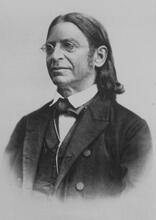Inés of Herrera
A young Spanish maiden named Inés of Herrera began to have visions at the end of the fifteenth century that provided hope for the judeoconversos, especially in the region of Extremadura in Castile. Her detailed descriptions of a visit to heaven and expectations of being transported to the Promised Land inspired numerous converted Jews to begin a return to Judaism. Because this movement spread so quickly, the Inquisition realized that it had to nip it in the bud. Consequently, as of 1500, they arrested twelve-year-old Inés, who was quickly tried and executed along with as many of her followers as they could locate. Most were found guilty although some of the very young girls were reconciled to the Church.
Inés and her Prophesies
Inés of Herrera del Duque was a conversa prophetess who appeared on the scene at the tail end of the fifteenth century. This twelve-year-old girl who had lost her mother began to have visions that excited and inspired many conversos, male and female, young and old. Herrera del Duque, located in the region of Extremadura in western Castile, was a center for leather workers such as tanners and cobblers; Juan Esteban, her father, was a shoemaker, who encouraged his daughter’s activities and helped to spread her prophecies. (He later fled to Portugal, avoiding trial by the Inquisition.)
By the time Inés’s visions began, her father had remarried; he and his second wife, Beatriz Ramírez, were clearly supportive of their daughter’s inspired path, encouraging all conversos whom they encountered to hear her prophecies. Inés began to report visions in August of 1499, with her deceased mother playing a central role. Inés described rising to heaven while accompanied by her beloved mother; there she met various angels. Among other things, she claimed to have seen that the souls of burned converso martyrs were seated on chairs of gold. In most of her reports, the prophet Elijah played a major role; he would be directing the future activities, which involved the arrival of the Messiah as well as travelling to the Promised Land. This land, sometimes presented as a city, would offer those arriving an abundance of bread and fruit; there were also descriptions of tables full of bread. This abundance of food especially appealed to the poorer among her followers.
The prophetess urged her followers to give alms and to follow her practice of fasting until nightfall on Mondays and Thursdays (the days for fasting advocated in Talmudic times, when confronted by drought or other difficulties). She urged the observance of the Sabbath by not working; she herself dressed up in her best clothes on that day. Inés was reported to have brought back tokens from her heavenly visits: in one version, she returned with corn, olives, and a letter, while in another, she brought back rye and carnations. Wonderful marital matches would be available for all of the maidens. En route, the conversos would traverse a river (like in the Exodus) while dressed in white, leaving all their jewelry behind. God himself would lead them. Historian Haim Beinart points out that many of these notions were similar to A type of non-halakhic literary activitiy of the Rabbis for interpreting non-legal material according to special principles of interpretation (hermeneutical rules).midrashim , a sign of the continued strength of the connection between the conversos and Jewish traditional literature.
Inés was arrested in April of 1500. At first, she was apparently given shelter by a count who was loathe to surrender her to the authorities, but she was soon apprehended and incarcerated for four months. Interrogations by the Inquisition began in May; in early August, the defendant was burned at the stake as a bona fide heretic.
Her Followers
In order to understand the success of this messianic movement, one must realize that it occurred a mere seven years following the expulsion of the Jews of Spain. While the majority elected to leave their homeland, the country simultaneously witnessed the creation of an additional group of judeoconversos or New Christians. Many of them became frustrated by their new unstable position in society, as well as their dubious religious stance, and mourned their past. A messianic movement, promising pardons to all the conversos who had sinned by observing Catholic rites, was welcomed warmly by them as well as by their children, although the latter did not have the same strong ties to Judaism as did their parents.
Although unfortunately the trial of the prophetess herself is missing from Inquisition records, extant Inquisition files contain the confessions of many of her followers and illustrate the power and attraction of this young girl’s messages. Quite a few older women, most of whom had already confessed to the Inquisition in the 1480s and were reconciled to the Church at that time, were strongly moved by this messianic development. Many began to observe the Sabbath on varying levels, to refrain from eating pork, and to fast on Yom Kippur as well as during the week. Likewise, they began to wear their best clothes on the Sabbath and to give alms to the poor.
A woman from Toledo was convinced that the messiah would pass through her city. Another made herself a special blouse for the journey. Yet another ceased doing any housework, as she anticipated an imminent departure for the Promised Land. Those who did not live in Herrera went to hear the tidings from Inés herself. One was taught a prayer; another was told to expect various signs appearing in the sky and was informed of the color of the ship that would come to transport them.
Beatriz Ramírez of Alcázar had married Juan Esteban, who convinced her of his daughter’s message and of her heavenly visit. In her confession of 1500, she mentioned being instructed to sing and dance for the maiden. Beatriz and other women shared their knowledge and excitement; word about these prophecies spread quickly.
Among younger followers, both married and single, there was also great enthusiasm. Some had ecstasies and began to sing and dance. One heard that an angel carried Inés to the sky and that believers in the messiah would pass through the entrance to the Promised Land while the others would remain behind. One conversa was difficult to convince, but once she changed her mind, she fasted, ate no bacon, and observed Shabbat by not opening her store until quite late on Saturdays. Another expected to see Elijah arrive in a cloud.
One girl reported that the prophetess would wed the son of the king of Judea; she herself was ready to depart at any moment, wearing all her jewels daily in preparation. Another maiden’s father visited Herrera, returning with news: the departure of the family including her step-mother and sisters was imminent. She began to light Sabbath candles and to fast in the hope of seeing her mother again; she was condemned in 1503.
There were a number of young girls who, like Inés and the aforementioned maiden, had lost their mothers. Each was assured that she would see her beloved mother and encounter good fortune as well. Some of the girls were cousins of the prophetess. One named Beatriz was in a particularly delicate situation. She was anxious to observe Jewish rites and to see her mother again but was a servant of an important court secretary who was a devout Old Christian. Any observance on her part had to be as clandestine as possible. She explained in her trial that she feared observing the Sabbath and dietary laws.
Another cousin stopped eating pork; when she attempted to fast, this eleven-year-old took ill. Because she was so young and still impressionable and her observance was minimal, she was given a light penance by the court. On the whole, the older women, who understood the implications of their actions and who had also forsaken their Jewish life, risked the most by observing. The younger girls were absolved in the hopes of retraining them to be good Catholics. Most, but not all, were beyond salvation; Inés, despite her tender age, was deemed a heretic whose threat was too great to ignore.
The Inquisition vs. Converso Messianism
The Spanish Inquisition was established in order to extirpate heresy; a baptized Catholic, believing in the Law of Moses and observing its rites and rituals, whether according to rabbinic standards or based on the intention behind the deed, qualified as a heretic. Once having cleared the country of its Jewish population, the Crown and the Church realized that they still had to contend with the conversos, a heterogenous group that included many new converts to Christianity whose connections to Judaism were still strong. Thus the Inquisition, established in 1478, continued to confront the suspected judaizers among them.
Upon learning of the existence of a messianic movement originating in Herrera but that also included a few lesser prophetic figures (Mari Gómez, who had come to hear Inés prophesy, and Luis Alonso of Chillón) during the same decade, the inquisitors were understandably alarmed. Once it became clear that these prophecies were spreading rapidly and gaining adherents, the threat became more serious. As a result, the Holy Tribunal made an effort to arrest every suspected leader and follower, of any age, and to quickly squelch the movement. The numerous confessions and witness descriptions recorded in the trials reflect the popularity of the movement and the attraction it held for many conversos. Inés herself was quickly apprehended and, as mentioned above, her trial was short. Unfortunately, without the proceedings of her trial, we cannot know if she confessed or if there was ample evidence of her prophetic activities and her messianic pronouncements to enable the court to quickly pronounce her guilt.
Born in 1488, Inés was burned at the stake in 1500; many of her followers suffered a similar fate, although the young girls, some of whom were related to the prophetess, were, on the whole, instructed to be reconciled to the Church. The fact that she gained so many followers in such a short time was proof that the Inquisition needed to act quickly; it succeeded in destroying the threat of the twelve-year-old conversa prophetess and the movement.
Beinart, Haim. “The Spanish Inquisition and a ‘Converso Community’in Extremadura,” Medieval Studies 43 (1981): 445-471.
Beinart, Haim. “The Prophetess Inés and Her Movement in Pueblo de Alcocer and Talarrubias” [Hebrew], Tarbiz 51 (1982): 633-658.
Beinart, Haim. “Conversos of Chillón and the Prophecies of Mari Gómez and Inés, the Daughter of Juan Esteban” [Hebrew], Zion 48 (1983): 241-272.
Beinart, Haim. “Inés of Herrera del Duque: The Prophetess of Extremadura,” Women in the Inquisition: Spain and the New World, edited by Mary E. Giles, 42-52, 304-310. Baltimore: The John Hopkins University Press, 1999.
Levine Melammed, Renée. Heretics or Daughters of Israel: The Crypto-Jewish Women Castile, 45-72, 216-219. New York: Oxford University Press, 1999.











